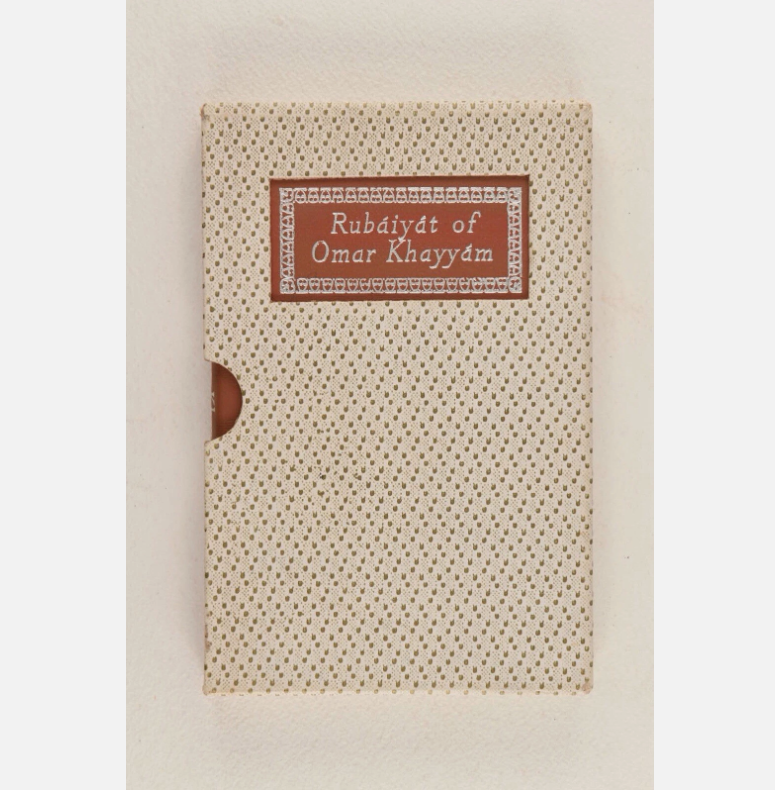Created by Noah Ryan-Richey on Sat, 05/24/2025 - 13:30
Description:
This edition, like many others, began with a publisher. The publisher for this edition is Collins Clear Type Press, now known as HarperCollins. HarperCollins is considered one of the top publishers in the English-speaking world. Collins was founded in 1819 in Glasgow, Scotland. They published this version of the Rubáiyát sometime in the late 1940s or early 1950s in Great Britain. They published this edition in their “Collins Greetings Booklets,” which contained other works such as “A Shakespeare Anthology”, “The Greatest Thing in the World”, and half a dozen other works. I believe the titles in the booklets were meant to be gift books. This is not their first time publishing the Rubáiyát, with an earlier publication in 1928 (ABAA). What is interesting is that the 1928 version contains an introduction by the same person, Laurence Housman. Laurence was originally an illustrator, though later in his career he became a playwright and writer.
Another aspect of this edition's history is that the illustrator, Marjorie Anderson, seems to have been an American, whereas the publisher, the editor, and, as mentioned earlier, Laurence, were all from Britain. How or why Marjorie came to illustrate this edition is not known, but she was an American illustrator. She was born in 1921 in Sand Springs, Oklahoma, and passed away in 2008 in Catoosa, Oklahoma. (Artist Biography & Facts Marjorie May Anderson) The General Editor of this edition was G. F. Maine, who was a Scottish editor and writer who worked for Collins. There isn’t a lot of information available about him and his life, or his work at Collins. He was born in 1894 and passed away in 1956 in Glasgow, Scotland. This book likely would’ve been one of the last ones he had the pleasure of editing before he passed away.
Something interesting in my research of this edition and its history is that this version of the book originally came with a sleeve or protector(Farmgirl’s Art Books Collectibles), which leads me to believe that this was meant to be a gift book. I’ve included a photo of the slipcover with its interesting design. And this differs from some other gift books as it has a very modest nature to it, with few illustrations inside its pages, and all of them black-and-white. Although I do not know what this edition originally cost, I can’t imagine it would’ve cost much. Its simplicity and current market price lead me to believe that.
I wish there were more information available about the creation of this edition and the people who worked on it. I truly do. But time, being the ever voracious mistress, consumes what was once known and leaves us only fragments. This edition fascinates me with its simple nature. It is plain in all the right ways. It leaves little to be desired and makes one appreciate what it contains. I like to think those who created this book wanted this outcome. That they were simple people who appreciated a book for its content, not its beauty. And as such, they created a gift book that replicates this.
Citations:
The Rubáiyát of Omar Khayyám Translated by Edward Fitzgerald. Introduction by Laurence Housman by Khayyam, Omar | Search for Rare Books | Abaa, www.abaa.org/book/1255449041. Accessed 24 May 2025.
“Artist Biography & Facts Marjorie May Anderson.” Marjorie May Anderson - Biography, www.askart.com/artist/Marjorie_May_Anderson/11173119/Marjorie_May_Anders.... Accessed 24 May 2025.
“Rubaiyat of Omar Khayyam Illus. by Marjorie Anderson HC with Slipcase English.” eBay, Farmgirl’s Art Books Collectibles, 6 Nov. 2024, www.ebay.com/itm/186560440336.


